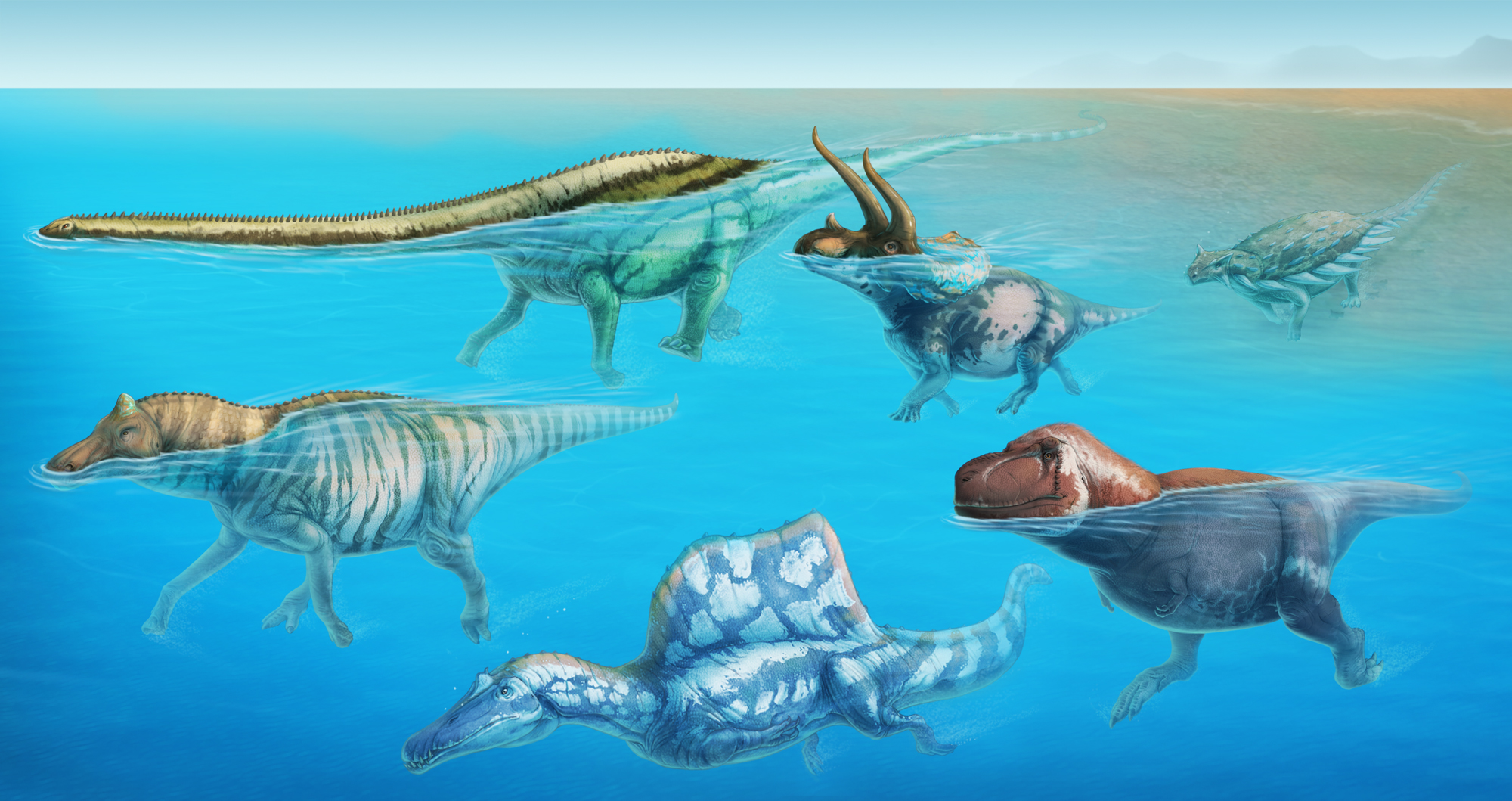
Publications Dinosaur densities press release
- Bruhathkayosaurus body mass
- Dinosaur densities press release
- Tetrapod body densities
- Sauropod Encyclopedia
- Palaeoloxodon skull evolution
- Palaeoloxodon poster
- Theropod Encyclopedia
- P. antiquus from Germany
- The Body Size of Proboscideans
- Siculo-Maltese dwarf elephants
- Songhua River Mammoths
- Dinogeography

An illustration showing dinosaurs of different densities in freshwater. The lightest, Diplodocus (top left) should have shown over 10% of its body above surface level when swimming, while at the other extreme the heavily armored Gargoyleosaurus (top right) was so dense that it probably bottom walked like today’s hippos.
(Image credit: Sante Mazzei).
New analysis finds that dinosaurs and pterosaurs, were denser, and therefore, heavier than we thought
Paleozoologists have been attempting to estimate how much extinct organisms weighed for many decades. In part for specific research purposes to better understand their biology. In part because some extinct animals reached exceptional masses. The best method for estimating the mass of fossil creatures is to produce a science based model restoration to best determine its volume. But most animals as not the exact same density as fresh water, they are usually a little above or below that value. But, how can then density of past organisms be correctly estimated? Are the densities that are estimating for these prehistoric creatures, realistic? According to a new study, the usually applied densities have been too low.
A recent and massive research published in the journal Anatomical Record, involved for the first time a deep review and reappraisal of body densities of dinosaurs and many other tetrapods and organisms living and extinct. Scientists have utilized the specific gravity (SG) value to measure different living and extinct organisms’ densities. SG in this case, is the density ratio between mass versus volume relative to freshwater that equals 1.0, so an organism or object with an SG above 1.0 would sink and vice versa will float.
The study shows that in the case of continental mammals most have an SG very close to 1.0, including bats, however, some semi-aquatic and armored species are significantly above that such as the case of hippos, which are so heavy boned and dense that they cannot surface swim. Most of the reptiles are also in the area of 1.0, however, they have a great ability to take enough air to increase or decrease buoyancy with no effort, and some species with huge respiratory systems, can reach a density even lower than lightest birds. Birds’ densities are greatly variable from as light as four fifths the density of water to equal the density of the last.
To reach to the above values, the team of researchers has developed new methodologies, which in case of extinct animals, takes into account the specific gravities of the different body parts including those of bones and soft tissues, and the probable respiratory system capacities. One means of analysis was also to examine images and videos of organisms floating, sinking and swimming in water to assess how dense they are. Thanks to this exhaustive analysis, they have reached to the best picture of the dinosaurs pterosaurs body densities to date. The results show that the commonly applied densities these extinct critters are up to 20% too low in case of some dinosaurs, and more in the case of pterosaurs.
“The main problem of the commonly applied densities to extinct animals, like dinosaurs, is that it is assumed that their respiratory system were always fully inflated because respiratory system capacity volume is usually measured at maximum inhalation in birds and other animals. This leads to a considerable underestimation of the real density of these animals because, in a neutral state, the respiratory system of most animals is approximately half or even less filled.” Lead study author Asier Larramendi, research director of Eofauna Scientific Research, said.
“This has also led to too overly low density estimates, even in living animals, particularly in birds.”
Theropod dinosaurs like Tyrannosaurs were likely to have an SG in the area 0.95 or somewhat greater approaching 1.0, which is a bit higher than big ground birds like an ostrich because the skeletons of extinct nonavian theropods, contrary of what is found in extant terrestrial birds, were not comparably pneumatized. On the other hand, ornithischians dinosaurs were more similar to mammals because their skeletons were not pneumatized, so most probable their SGs were at around 1.0, although there were some exceptions. For example, the authors studied in detail the SG of a Stegosaurus and found that the dorsal midline plates and spikes would have increased its SG to about 1.08. Even denser may have been some species of heavily armored ankylosaurs, probably preventing them from surface swimming.
Researchers also made the most sophisticated effort to date for a sauropod. Sauropod dinosaurs ventilation was different from mammals because along with lungs they possessed a bird-like system of air sacs and diverticula, plus some pneumatic bones that could include some air inside them, so this complicates matters greatly. However, for the study, a full skeleton of a Diplodocus skeleton was scanned by photogrammetry, and in order to have the full volume of the animal, the living aspect of the animal was restored by carefully adding the muscles and skin. Later the air inside the body was calculated by 3D software including those of bones and that of the complex system of pneumatic diverticula. Finally, applying the different body components known densities, the overall density of the animal was calculated, and found that sauropods were lighter than mammals but not significantly, with SGs approaching to 0.95, and with neck SGs ranging from ~0.8 to about 0.95, which is much higher than previously thought.

CM 84/ USNM 1065 Diplodocus 3D reconstruction including pneumatic diverticula complexes (Image credit: Shu-yu Hsu co-author of the study).
Volumetric analysis on carefully restored pterosaur species showed that these prehistoric flyers’ SGs, were comparable to that of living birds in both, in variability and density, being the lightest of pterosaurs just barely lighter than lightest living birds.
Gregory Paul, co-author of the study, said “I helped initiate the modern effort to restore the masses of dinosaurs and pterosaurs in the 1980s using the first carefully reconstructed extensive set of skeletal restorations, which will always be the most reliable means of doing so. Because of extensive research into their form and function restoring the volume of dinosaurs is well understood. But once one has a volume that needs to be adjusted according to the density of the animal to arrive at a weight value. For many decades the information on that has been misleading, implying that animal densities are lower that the actually are, leading to dinosaur and pterosaur masses being underestimated even when the volume is correctly restored. This unprecedented study goes a long way to correcting that problem. We also for the first time present a large body of specific gravity data on a large variety of organisms from low density woods to extra dense corals that has not been conveniently gathered together before.”





